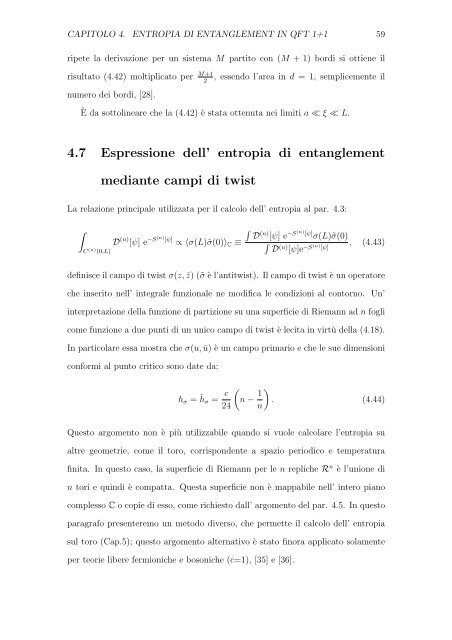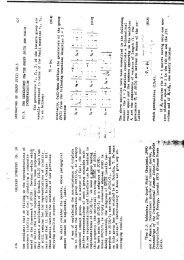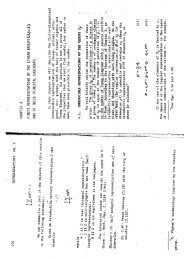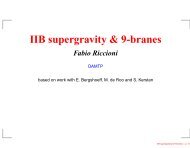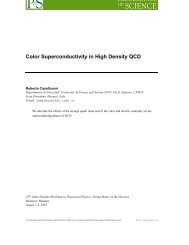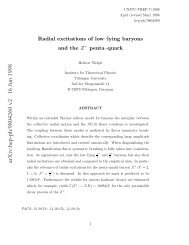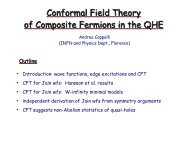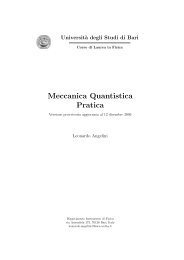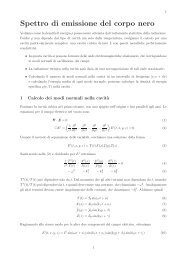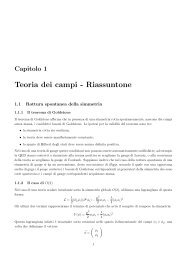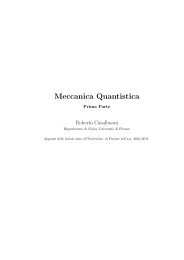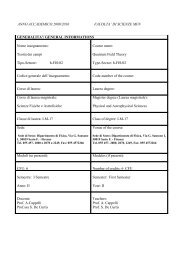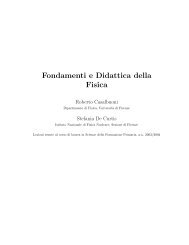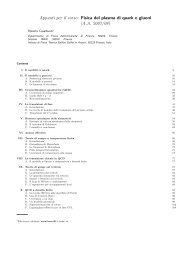entropia di entanglement in teorie invarianti conformi bidimensionali
entropia di entanglement in teorie invarianti conformi bidimensionali
entropia di entanglement in teorie invarianti conformi bidimensionali
You also want an ePaper? Increase the reach of your titles
YUMPU automatically turns print PDFs into web optimized ePapers that Google loves.
CAPITOLO 4. ENTROPIA DI ENTANGLEMENT IN QFT 1+1 59<br />
ripete la derivazione per un sistema M partito con (M + 1) bor<strong>di</strong> si ottiene il<br />
risultato (4.42) moltiplicato per M+1<br />
2 , essendo l’area <strong>in</strong> d = 1, semplicemente il<br />
numero dei bor<strong>di</strong>, [28].<br />
È da sottol<strong>in</strong>eare che la (4.42) è stata ottenuta nei limiti a ≪ ξ ≪ L.<br />
4.7 Espressione dell’ <strong>entropia</strong> <strong>di</strong> <strong>entanglement</strong><br />
me<strong>di</strong>ante campi <strong>di</strong> twist<br />
La relazione pr<strong>in</strong>cipale utilizzata per il calcolo dell’ <strong>entropia</strong> al par. 4.3:<br />
<br />
C (n) (0,L)<br />
D (n) [ψ] e −S(n) [ψ] ∝ 〈σ(L)˜σ(0)〉C ≡<br />
<br />
(n) −S D [ψ] e (n) [ψ] σ(L)˜σ(0)<br />
<br />
D (n) [ψ]e−S (n) , (4.43)<br />
[ψ]<br />
def<strong>in</strong>isce il campo <strong>di</strong> twist σ(z, ¯z) (˜σ è l’antitwist). Il campo <strong>di</strong> twist è un operatore<br />
che <strong>in</strong>serito nell’ <strong>in</strong>tegrale funzionale ne mo<strong>di</strong>fica le con<strong>di</strong>zioni al contorno. Un’<br />
<strong>in</strong>terpretazione della funzione <strong>di</strong> partizione su una superficie <strong>di</strong> Riemann ad n fogli<br />
come funzione a due punti <strong>di</strong> un unico campo <strong>di</strong> twist è lecita <strong>in</strong> virtù della (4.18).<br />
In particolare essa mostra che σ(u, ū) è un campo primario e che le sue <strong>di</strong>mensioni<br />
<strong>conformi</strong> al punto critico sono date da:<br />
hσ = ¯ hσ = c<br />
<br />
n −<br />
24<br />
1<br />
<br />
. (4.44)<br />
n<br />
Questo argomento non è più utilizzabile quando si vuole calcolare l’<strong>entropia</strong> su<br />
altre geometrie, come il toro, corrispondente a spazio perio<strong>di</strong>co e temperatura<br />
f<strong>in</strong>ita. In questo caso, la superficie <strong>di</strong> Riemann per le n repliche R n è l’unione <strong>di</strong><br />
n tori e qu<strong>in</strong><strong>di</strong> è compatta. Questa superficie non è mappabile nell’ <strong>in</strong>tero piano<br />
complesso C o copie <strong>di</strong> esso, come richiesto dall’ argomento del par. 4.5. In questo<br />
paragrafo presenteremo un metodo <strong>di</strong>verso, che permette il calcolo dell’ <strong>entropia</strong><br />
sul toro (Cap.5); questo argomento alternativo è stato f<strong>in</strong>ora applicato solamente<br />
per <strong>teorie</strong> libere fermioniche e bosoniche (c=1), [35] e [36].


